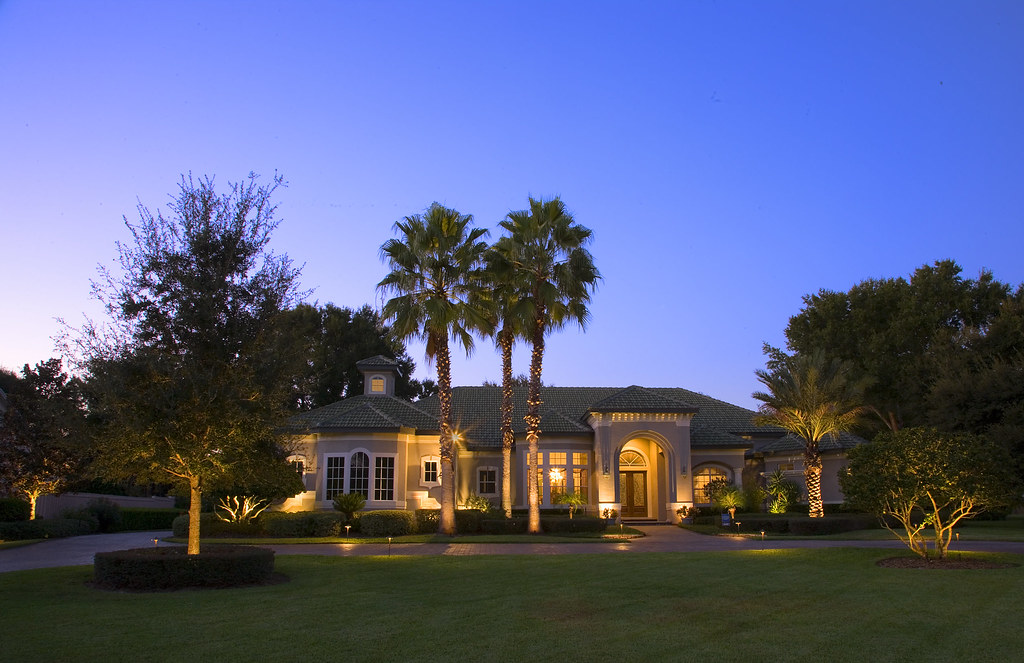Landscape lighting transcends mere illumination; it artfully enhances the natural beauty and functional usability of outdoor spaces during the twilight hours. Specifically, when it comes to trees, strategic lighting can transform these natural elements into dramatic features that captivate and add depth to the landscape. This type of lighting, which often incorporates principles of architectural lighting, not only increases the aesthetic appeal but also boosts safety and extends the usability of your outdoor areas after dark.
In this comprehensive guide, we will explore the myriad benefits and techniques of landscape lighting, particularly focusing on trees. From understanding the basics of landscape lighting to delving into advanced lighting techniques, including architectural lighting approaches, readers will gain insights into how to effectively illuminate trees to enhance both their property’s beauty and functionality.
Basics of Landscape Lighting
Landscape lighting is a critical component of outdoor design that serves multiple purposes, from improving the aesthetic appeal of a property to enhancing its security. At its core, landscape lighting involves strategically placing light fixtures throughout outdoor spaces to highlight landscape features and improve visibility at night.
By illuminating trees and other elements, landscape lighting creates a visually appealing scene that can transform the look and feel of a property after sunset. Well-lit paths and entranceways increase the safety of these areas, reducing the risk of trips and falls, while also deterring potential intruders by eliminating dark spots in the yard. This guide will also provide tips on how to install outdoor lighting, ensuring that homeowners can effectively implement these lighting strategies themselves.
Key Elements of Tree Lighting
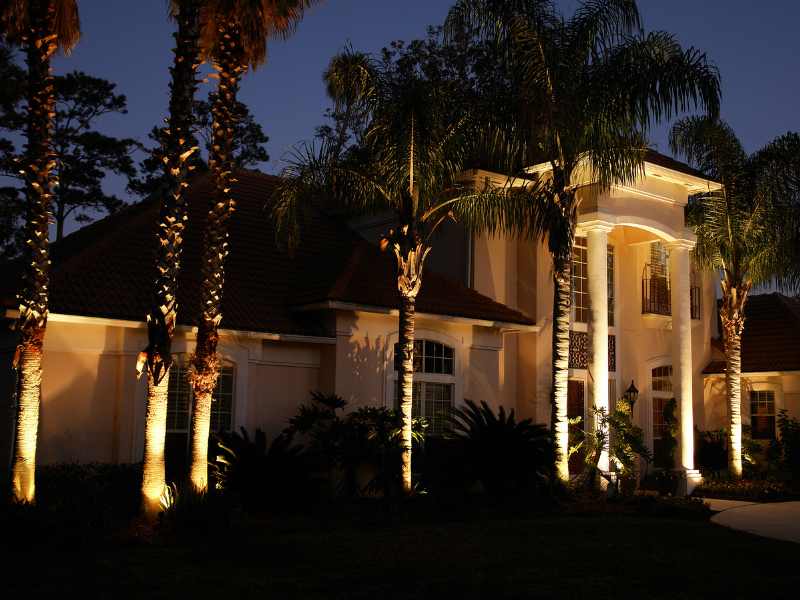
Tree lighting is a specialized segment of landscape lighting that focuses on accentuating the natural beauty and distinctive characteristics of trees within an outdoor space. Unlike general landscape lighting that might aim to illuminate pathways, steps, or entire garden areas, tree lighting requires a more nuanced approach, emphasizing the unique forms, sizes, and types of trees. This targeted illumination not only highlights the majestic or delicate features of trees but also adds depth and drama to the landscape at night.
The art of tree lighting involves considering several crucial factors:
- Form of the Tree: The natural shape and branching pattern should guide the placement and type of lights used. For instance, trees with a wide canopy might need different lighting compared to columnar trees.
- Size of the Tree: Larger trees require lights with greater output and a broader beam to adequately illuminate their entire form from trunk to canopy.
- Type of Tree: Deciduous trees with seasonal foliage changes need adaptable lighting to highlight their structure and texture throughout the year, whereas evergreens may require consistent lighting that focuses on the density and color of their needles.
Understanding these elements ensures that each tree is shown in its best light, contributing to a cohesive and captivating landscape lighting design that enchants observers after dusk.
Choosing the Right Light Source
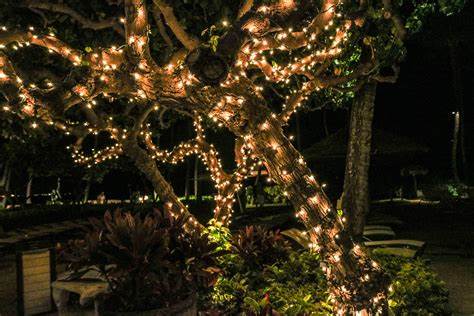
The selection of the appropriate light source is pivotal in landscape lighting, especially when illuminating trees. The evolution of lighting technology offers various options, each with its advantages and limitations.
LED vs. Traditional Lighting
LED lighting has become increasingly popular for outdoor use, primarily due to its efficiency and longevity compared to traditional options like halogen or incandescent bulbs. Here’s how LED stands out:
- Energy Efficiency: LEDs consume significantly less power, which not only reduces energy costs but also minimizes the environmental impact of your lighting system.
- Longevity: LED bulbs have a longer lifespan, often lasting thousands of hours longer than their traditional counterparts, reducing the frequency of replacements.
- Variability: Modern LED technology offers a range of color temperatures and brightness levels, making them versatile for different lighting needs in the landscape.
Importance of Beam Angle and Light Output
Choosing the right beam angle and adjusting the light output are crucial steps in designing effective tree lighting. These elements determine how light interacts with the physical features of the tree and the surrounding landscape.
- Selecting Beam Angle:
- Small Trees: Narrow beam angles are ideal for highlighting the intricate details of smaller trees or focusing light on specific parts of the tree.
- Large Trees: A wider beam angle can illuminate a larger tree in its entirety, providing a uniform glow that enhances its presence in the landscape.
- Unique Form Trees: Trees with unusual shapes might benefit from a combination of narrow and wide beam angles to accentuate their unique features effectively.
- Adjusting Light Output:
- Brightness Levels: The intensity of the light should complement the environment and the tree’s natural colors without overpowering them.
- Visibility and Safety: Adequate light output ensures that the tree not only becomes a visual feature at night but also contributes to the safety and navigability of the outdoor space.
Through thoughtful consideration of beam angle and light output, landscape designers can create a visually appealing and functional night-time environment that highlights the beauty of trees while catering to the practical needs of the space.
Techniques for Lighting Different Types of Trees
Illuminating trees in your landscape not only enhances their natural beauty but also elevates the overall ambiance of your outdoor space. Different techniques are employed to achieve various effects, depending on the type of tree and the desired aesthetic. Understanding these techniques is crucial for any successful outdoor lighting project.
Uplighting:
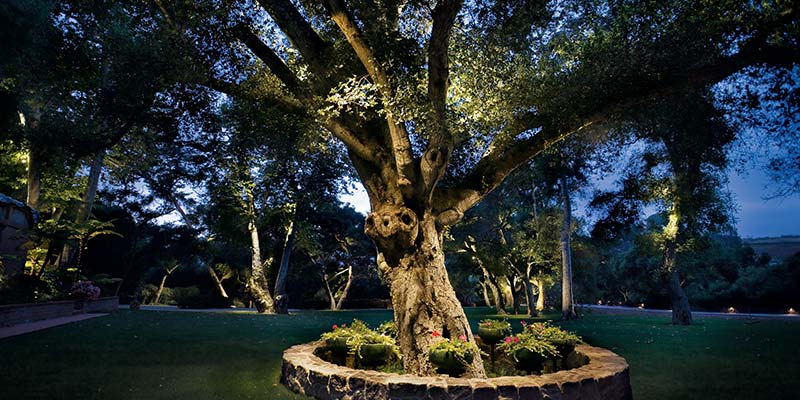
This technique involves placing lights at the base of the tree to shine upward, highlighting the trunk and canopy. It creates dramatic shadows and emphasizes the tree’s structure, making it ideal for showcasing tall or uniquely formed trees.
Downlighting:
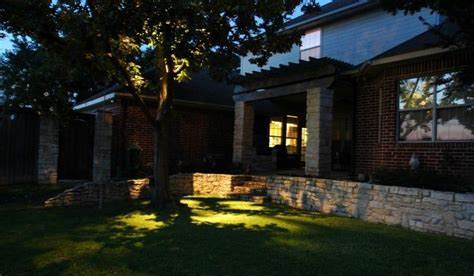
Lights are installed high in the tree or from a structure above, casting light downward as if mimicking moonlight. This method is excellent for creating a subtle and natural ambiance, suitable for areas where a soft glow is preferred.
Backlighting:
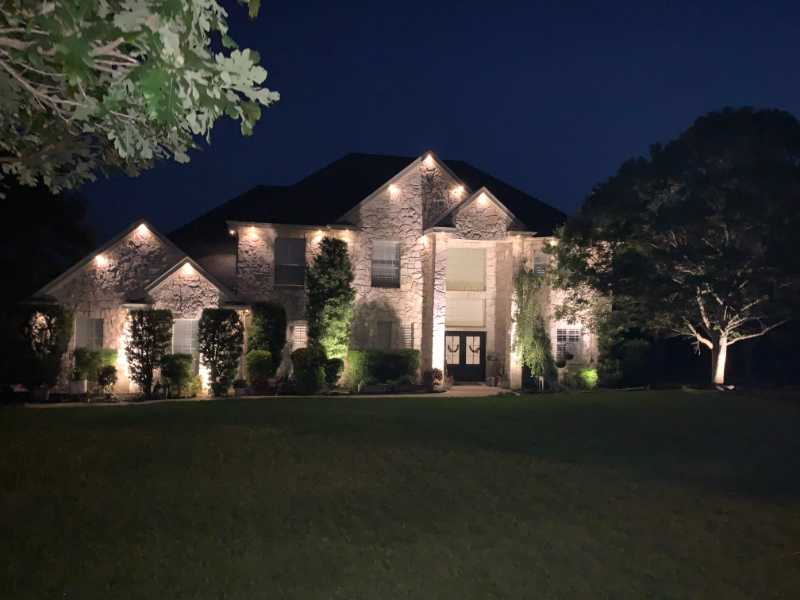
Positioning lights behind the tree to silhouette it against a wall or darker background creates a striking visual contrast. This technique is less about highlighting the tree itself and more about creating a dramatic backdrop in the landscape.
Each of these techniques can be adapted to suit different types of trees, from deciduous to evergreen, enhancing their individual characteristics.
Lighting Tall Trees vs. Smaller Trees
When it comes to lighting trees in your landscape, size matters. The techniques used for illuminating a majestic oak differ significantly from those employed for a petite Japanese maple. Understanding these differences is crucial for creating a captivating nighttime landscape that showcases the beauty of your arboreal elements.
Challenges and Strategies for Lighting Tall Trees Effectively
Lighting tall trees requires powerful LED fixtures with high-lumen output to reach the uppermost branches. Use multiple lights at different angles for even illumination from ground to canopy. Consider color temperature: warm lighting (2700K-3000K) creates a cozy atmosphere, while cooler temperatures (4000K-5000K) mimic moonlight, ideal for silver or blue-green foliage. Adjust lighting seasonally, repositioning or changing intensity as needed.
For very tall trees, mount lights on nearby structures or within the large tree (with arborist guidance) to achieve the desired illumination. This approach creates dramatic uplighting effects, highlighting the entire structure and preventing dark spots, resulting in a balanced nighttime appearance.
Techniques Tailored for Enhancing Smaller Trees within a Landscape
Smaller trees offer opportunities for precise illumination. Use fixtures with narrow beam angles to highlight specific features like bark textures or branch structures. Combine low-level path lighting with focused uplighting for depth and visual interest, drawing the eye upward. Create intriguing shadows or dramatic silhouettes by placing lights behind trees.
For ornamental varieties, consider color-changing LED fixtures for dynamic seasonal effects. Incorporate smaller tree lighting into the overall landscape design, using them as focal points in garden beds or to frame pathways and entrances. These techniques emphasize the tree’s form and texture, making smaller trees appear more impactful within the landscape.
Enhancing Visual Interest with Color Temperature
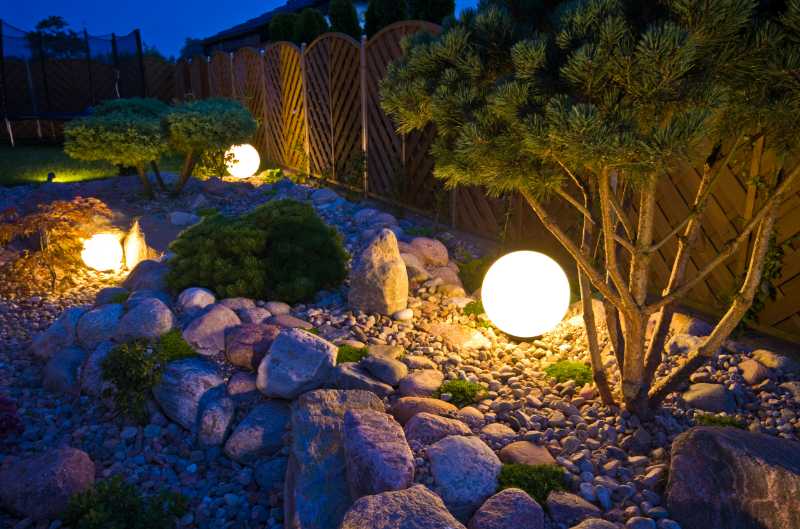
The choice of color temperature in landscape lighting plays a crucial role in setting the mood and enhancing the visual appeal of outdoor spaces. Color temperature refers to the hue of the light emitted from a light source, measured in Kelvin (K). Lower Kelvin numbers produce warm, yellowish light, while higher Kelvin values emit cooler, bluish light. The impact of these temperatures can dramatically alter the perception and ambiance of an area.
Warm Lighting Effects
Warm light, typically around 2700K to 3000K, creates a cozy and inviting atmosphere. It’s ideal for highlighting the rich hues of wood on tree trunks and can make green foliage appear deeper and more vibrant, which is perfect for residential gardens where a soft and welcoming glow is desired.
Cool Lighting Effects
Cooler light temperatures, ranging from 4000K to 6500K, offer a more clinical and bright light. This type of lighting is excellent for security purposes and for trees in more modern or industrial landscapes where a sharp, contemporary look is needed.
Integrating Lighting with Other Landscape Features
Integrating tree lighting with other landscape elements, such as water features, garden paths, and exterior architectural design, requires careful planning. Here’s how to create a cohesive and harmoniously lit outdoor space:
- Complementing Features: Coordinate the lighting style and color temperature with other illuminated elements to ensure a unified look. For example, use similar lighting temperatures for both the trees and nearby water features to create a seamless aesthetic transition.
- Positioning for Impact: Position lights to complement the landscape without overpowering it. Lights should be placed to enhance the tree’s natural beauty and integrate with the surrounding features, considering both functionality and artistic composition.
- Viewing Angles and Distances: Utilize various viewing angles to highlight different aspects of the trees and landscape. The positioning of lights should consider the typical viewpoints from inside and outside the property, ensuring that the illuminated trees serve as focal points from all relevant perspectives.
Through these strategies, landscape lighting can transform an ordinary outdoor space into an elegant, well-coordinated environment that enhances both the functional and aesthetic quality of the property.
Common Mistakes to Avoid in Tree Lighting
Even well-intentioned landscape lighting projects can encounter pitfalls, particularly when lighting trees. Being aware of these can help prevent common errors that detract from the desired outcome:
- Over-lighting: Installing too many lights or lights that are too bright can lead to a harsh, unappealing glow rather than enhancing the tree’s natural beauty.
- Wrong Fixture Placement: Lights placed incorrectly can create unwanted shadows or fail to highlight the tree’s best features. Ensure lights are positioned to optimize the tree’s appearance from key viewing angles.
- Ignoring the Big Picture: Tree lighting should integrate seamlessly with the rest of the landscape lighting. Neglecting this can result in a disjointed appearance that lacks cohesion.
Advanced Lighting Techniques and Technologies
Advancements in lighting technology have introduced new possibilities for landscape lighting, enabling more sophisticated and energy-efficient setups.
- Automated Systems and Smart Lighting Options: Modern systems allow homeowners to control lighting remotely via smartphone apps. These systems can adjust lighting based on the time of day, weather conditions, or specific events, offering both convenience and energy efficiency.
- Tailoring LED Technology: Cutting-edge LED technology can be customized to suit specific needs of the landscape, from adjusting color temperatures to suit the mood, to configuring beam widths for optimal tree illumination. This flexibility allows for creating targeted effects, whether dramatic or subtle, that enhance the landscape’s natural features.
By understanding and applying these advanced lighting techniques and technologies, landscape designers and homeowners can greatly enhance the functionality, beauty, and appeal of their outdoor environments.
Uplighting Trees to Create Drama
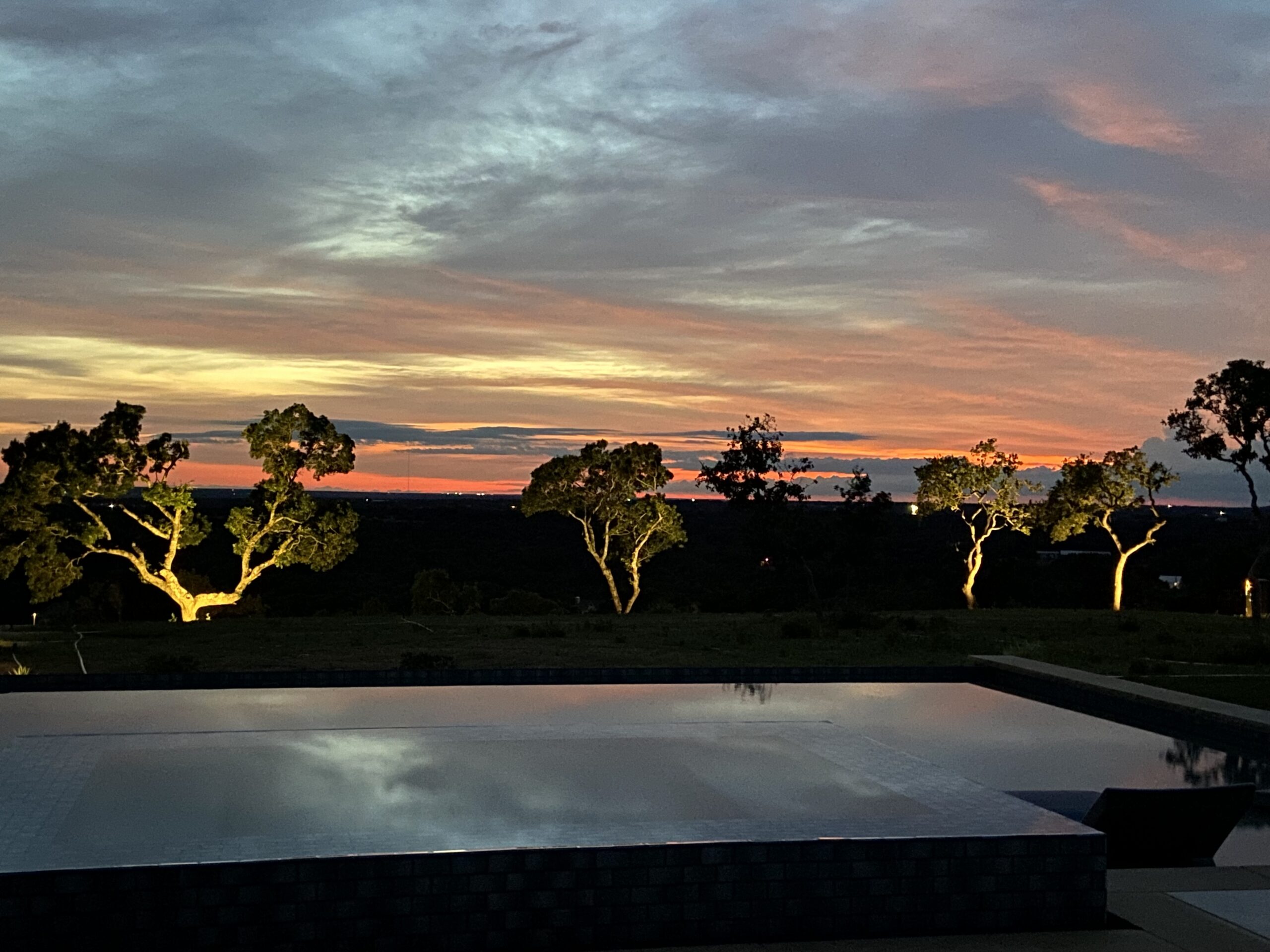
Uplighting is a dynamic technique used to illuminate trees from below, enhancing their natural forms and creating dramatic shadows that add depth to the landscape. Select lighting fixtures that are robust and can be angled precisely. Position them at the base of the tree aiming upward to maximize the tree’s architectural features.
Adjust the light’s intensity and beam angle to highlight the tree’s best features. For larger trees, a wider beam might be necessary to illuminate the entire canopy, while smaller or more intricate trees may benefit from a narrower beam focusing on specific details.
The aesthetic benefits of uplighting are significant for Deciduous trees and Evergreen trees. In deciduous trees, uplighting can enhance the texture and color of the bark and the intricate patterns of the branches, especially in the leafless months. For evergreens, uplighting accentuates the dense foliage and can create a permanent visual anchor in the landscape, regardless of the season.
Transform Your Nighttime Landscape With Professionals
The transformative power of properly implemented landscape lighting cannot be overstated. It has the ability to turn an ordinary garden into a spectacular night-time vista that enhances the natural forms and textures of trees. This not only increases the enjoyment of your property but can also add to its value.
Whether you are looking to update your existing landscape lighting or planning a new outdoor lighting project, consider consulting with a lighting professional. Their expertise will ensure that your investment not only meets your aesthetic expectations but also adheres to the highest standards of quality and safety. Don’t hesitate to reach out and start the conversation that could illuminate your property in ways you’ve never imagined.

